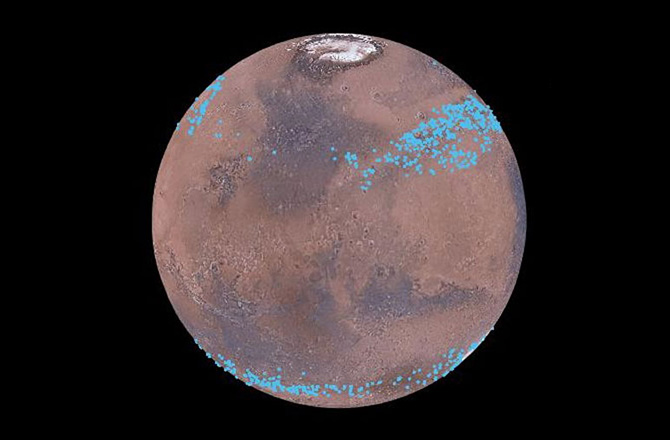The discovery of glaciers is melting under the layer of dust on the surface of Mars
Recently, scientists have discovered many glaciers "hidden" under the thick layer of sand on the surface of Mars. This is said to be the source of water reserves exist on the red planet.
Glaciers are melting under the sand on the surface of Mars
Discovery News reports the latest science from Geophysical Research Letters, scientists have discovered the existence of glaciers (glaciers) lying beneath the dust on the Martian surface, containing enough water to to cover the red planet with more than 1 meter thick ice.
Nanna Bjørnholt Karlsson, a researcher at the Niels Bohr Institute at the University of Copenhagen, said: "We estimate ice reserves in glaciers equivalent to more than 150 billion cubic meters of water - this amount can cover the entire Mars surface with a band of about 1.1 meters thick ".

Detection of thick ice under the surface of Mars
Previous radar images show that thousands of glaciers are buried beneath the Martian surface at the northern hemisphere and the southern hemisphere's red hemisphere . The data has been included in the computer model to measure ice flow to determine the size of glaciers, from which the estimated amount of water exists on the surface of Mars.
Nanna Bjørnholt Karlsson added: " We have been tracking radar devices for the past 10 years to consider the thickness and the state of transformation of glaciers. The results show that a river The ice was created by the slow melting of a large piece of ice on the surface of Mars, and we then compared this to the characteristics of the glacier on Earth to calculate whether ice flow exists on the planet. how much red is'.
Glaciers are located in the perimeter around Mars , between latitudes 30 and 50, which is equivalent to the position south of Denmark on Earth and found on both the northern and southern hemispheres.

Glaciers under the layer of dust are dense below the surface of Mars, the source of water reserves on the red planet
This finding could be an important clue to knowing the active states of water on Mars . The red planet, which now only sees dry, cold deserts, is known to have had oceans and lakes and used to be a suitable habitat for microorganisms.
Karlsson said: " The layers of ice at intermediate latitudes are the source of the currents on Mars's surface." Scientists suspect the thick layer of dust on the surface of Mars covered the ice from evaporating water into space.
- The world's fastest melting glaciers through satellite images 30 years apart
- Detecting 'ghost dust' on red planet
- The Andes glaciers narrowed the record
- When the glaciers in Iceland melt into small streams
- Antarctic glaciers are melting at a rapid rate
- What is the small green spot on Mars's surface?
- 20% of Canadian glaciers disappeared in this century
- The appearance of Mars suddenly changed completely after the dust storm
- Himalayan glaciers threaten millions of people
- Find the main culprit causing the glaciers to melt
- Glaciers in Asia are unusually bloated
- Antarctic glaciers are melting faster
 Van Allen's belt and evidence that the Apollo 11 mission to the Moon was myth
Van Allen's belt and evidence that the Apollo 11 mission to the Moon was myth The levels of civilization in the universe (Kardashev scale)
The levels of civilization in the universe (Kardashev scale) Today Mars, the sun and the Earth are aligned
Today Mars, the sun and the Earth are aligned The Amazon owner announced a secret plan to build a space base for thousands of people
The Amazon owner announced a secret plan to build a space base for thousands of people